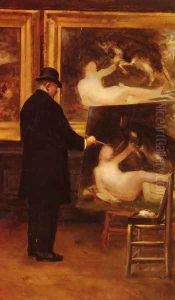George Louis Hyon Paintings
George Louis Hyon, born in 1876 in France, was a notable artist whose work reflects the aesthetic transitions of the late 19th and early 20th centuries. His artistic journey is a testament to the period's dynamic shifts in art styles and the influence of broader cultural and technological changes on individual artists. Although not as widely recognized as some of his contemporaries, Hyon's contributions to the art world are appreciated for their unique blend of traditional and emerging styles of his time.
Hyon's early work was deeply influenced by the prevailing trends of the late 19th century, particularly Impressionism, which aimed to capture the fleeting effects of light and color in the natural world. However, as he matured as an artist, his style evolved, reflecting the broader shifts in the art world towards Post-Impressionism and Symbolism. This period was marked by artists' desires to convey deeper emotional or spiritual truths, rather than merely depict the world as it appears.
Throughout his career, George Louis Hyon remained committed to exploring the possibilities of color and form. His paintings often exhibit a keen interest in the interplay of light, with a distinctive use of color that hints at the emotional or symbolic undercurrents of his subjects. Despite the evolving trends in art during his lifetime, Hyon maintained a personal vision that subtly incorporated influences from various movements, including Realism, Impressionism, and Symbolism, without fully aligning with any single style.
Hyon's body of work includes landscapes, portraits, and still lifes, each demonstrating his versatile talent and ability to capture the essence of his subjects with sensitivity and insight. While he may not have achieved the same level of fame as some of his peers, his art continues to be appreciated by connoisseurs and collectors for its unique charm and the window it offers into the transitional period of art history in which he lived and worked.
George Louis Hyon passed away in 1949, leaving behind a legacy that, though perhaps modest in comparison to the giants of his era, is cherished for its contribution to the rich tapestry of early 20th-century art. His work remains a subject of interest for art historians and enthusiasts who seek to understand the nuanced shifts in style and technique that characterized this vibrant period in the history of art.
